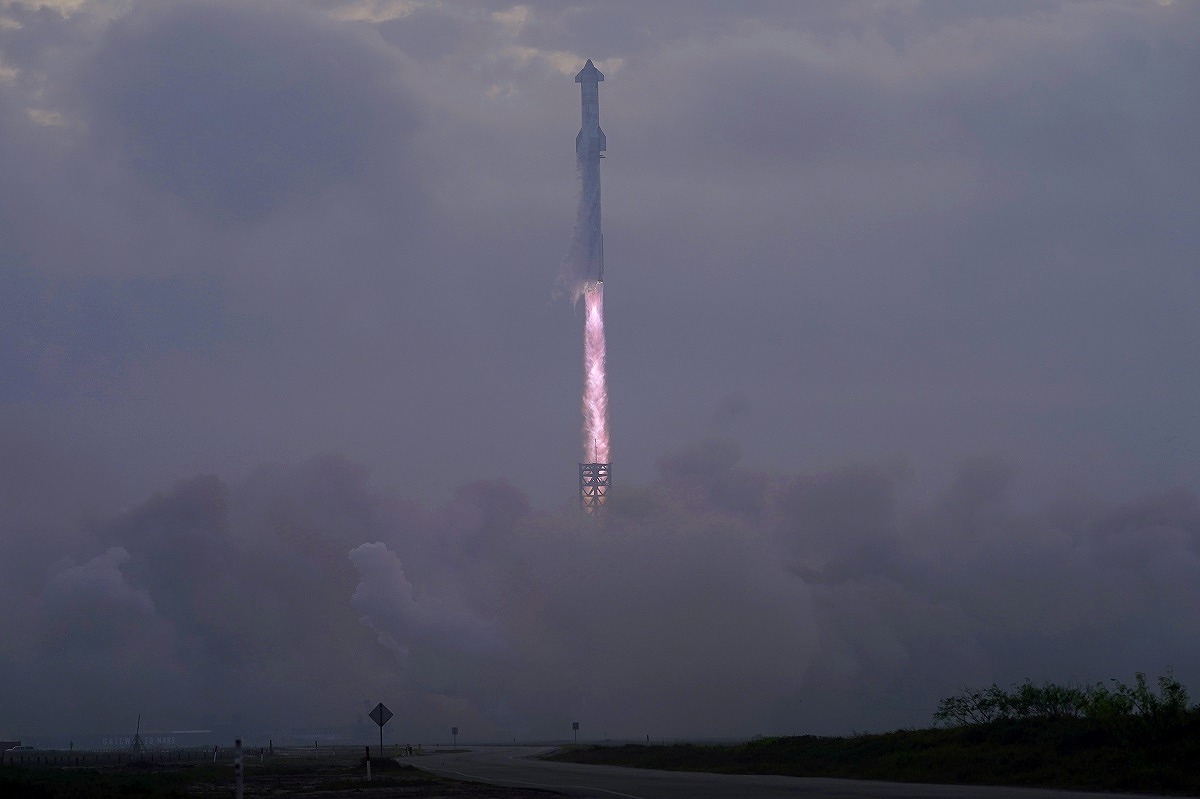SpaceX Comes Close to Completing Test Flight of Mega Rocket But Loses Spacecraft Near End

SpaceX’s mega rocket Starship launches at dawn in the haze on it’s third test flight from Starbase in Boca Chica, Texas, Thursday, March 14, 2024.
11:46 JST, March 15, 2024
SpaceX came close to completing an hourlong test flight of its mega rocket on its third try Thursday, but the spacecraft was lost as it descended back to Earth.
The company said it lost contact with Starship as it neared its goal, a splashdown in the Indian Ocean. The first-stage booster also ended up in pieces, breaking apart much earlier in the flight over the Gulf of Mexico after launching from the southern tip of Texas near the Mexican border.
“The ship has been lost. So no splashdown today,” said SpaceX’s Dan Huot. “But again, it’s incredible to see how much further we got this time around.”
Two test flights last year both ended in explosions minutes after liftoff. By surviving for close to 50 minutes this time, Thursday’s effort was considered a win by not only SpaceX’s Elon Musk, but NASA as well as Starship soared higher and farther than ever before. The space agency is counting on Starship to land its astronauts on the moon in another few years.
The nearly 400-foot (121-meter) Starship, the biggest and most powerful rocket ever built, headed out over the Gulf of Mexico after liftoff Thursday morning, flying east. Spectators crowded the nearby beaches in South Padre Island and Mexico.
A few minutes later, the booster separated seamlessly from the spaceship, but broke apart 1,500 feet (462 meters) above the gulf, instead of plummeting into the water intact. By then, the spacecraft was well to the east and continuing upward, with no people or satellites on board.
Starship reached an altitude of about 145 miles (233 kilometers) as it coasted across the Atlantic and South Africa, before approaching the Indian Ocean. But 49 minutes into the flight — with just 15 minutes remaining — all contact was lost and the spacecraft presumably broke apart.
At that point, it was 40 miles (65 kilometers) high and traveling around 16,000 mph (25,700 kph).
SpaceX’s Elon Musk had just congratulated his team a little earlier. “SpaceX has come a long way,” he said via X, formerly called Twitter. The rocket company was founded exactly 22 years ago Thursday.
NASA watched with keen interest: The space agency needs Starship to succeed in order to land astronauts on the moon in the next two or so years. This new crop of moonwalkers — the first since last century’s Apollo program — will descend to the lunar surface in a Starship after transferring from NASA’s Orion capsule in lunar orbit.
NASA Administrator Bill Nelson quickly congratulated SpaceX on what he called a successful test flight as part of the space agency’s Artemis moon-landing program.
The stainless steel, bullet-shaped spacecraft launched atop a first-stage booster known as the Super Heavy. Both the booster and the spacecraft are designed to be reusable, although they were never meant to be salvaged Thursday.
On Starship’s inaugural launch last April, several of the booster’s 33 methane-fueled engines failed and the booster did not separate from the spacecraft, causing the entire vehicle to explode and crash into the gulf four minutes after liftoff.
SpaceX managed to double the length of the flight during November’s trial run. While all 33 engines fired and the booster peeled away as planned, the flight ended in a pair of explosions, first the booster and then the spacecraft.
The Federal Aviation Administration reviewed all the corrections made to Starship, before signing off on Thursday’s launch. The FAA said after the flight that it would again investigate what happened. As during the second flight, all 33 booster engines performed well during ascent, according to SpaceX.
Initially, SpaceX plans to use the mammoth rockets to launch the company’s Starlink internet satellites, as well as other spacecraft. Test pilots would follow to orbit, before the company flies wealthy clients around the moon and back. Musk considers the moon a stepping stone to Mars, his ultimate quest.
NASA is insisting that an empty Starship land successfully on the moon, before future moonwalkers climb aboard. The space agency is targeting the end of 2026 for the first moon landing crew under the Artemis program, named after the mythological twin sister of Apollo.
"News Services" POPULAR ARTICLE
-

American Playwright Jeremy O. Harris Arrested in Japan on Alleged Drug Smuggling
-

Japan’s Nikkei Stock Average as JGB Yields, Yen Rise on Rate-Hike Bets
-

Japan’s Nikkei Stock Average Licks Wounds after Selloff Sparked by BOJ Hike Bets (UPDATE 1)
-

Japan’s Nikkei Stock Average Buoyed by Stable Yen; SoftBank’s Slide Caps Gains (UPDATE 1)
-

Japanese Bond Yields Zoom, Stocks Slide as Rate Hike Looms
JN ACCESS RANKING
-

Keidanren Chairman Yoshinobu Tsutsui Visits Kashiwazaki-Kariwa Nuclear Power Plant; Inspects New Emergency Safety System
-

Imports of Rare Earths from China Facing Delays, May Be Caused by Deterioration of Japan-China Relations
-

Tokyo Economic Security Forum to Hold Inaugural Meeting Amid Tense Global Environment
-

University of Tokyo Professor Discusses Japanese Economic Security in Interview Ahead of Forum
-

Japan Pulls out of Vietnam Nuclear Project, Complicating Hanoi’s Power Plans


























